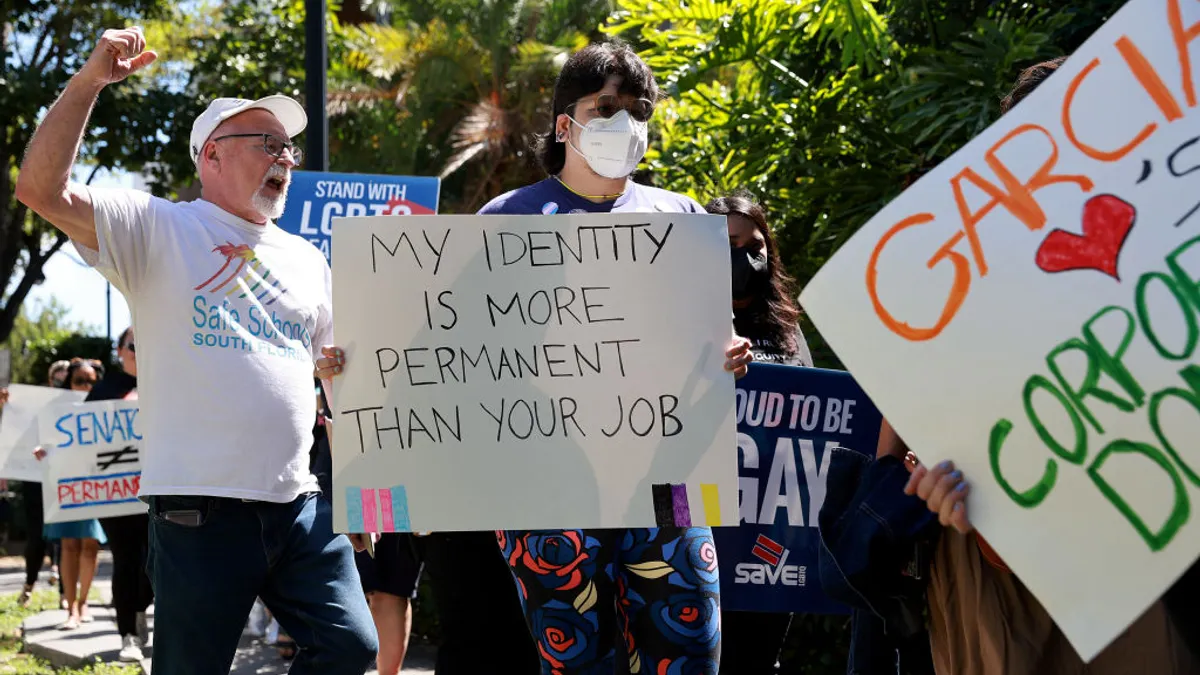One small number was perhaps the biggest news of 2019: the low unemployment rate. The tight talent market has inspired many recent employment trends, from the importance of learning to the evolution of recruiting. So long as the market continues to contract, these trends will likely deepen even as new challenges appear in 2020.
The evolution of technology, employment law and the way work gets done will also shape 2020, according to experts who spoke to HR Dive. As the work world changes, HR professionals from every industry will face similar challenges. Below, HR Dive lays out what experts and observers forecast for the year ahead.
It's time to plan for C-suite shakeups
Several top companies ended 2019 with a series of executive departures. These included exits at McDonald's, including former CEO Steve Easterbrook, and at LinkedIn, where former chief people officer Christina Hall stepped down. The specifics behind each departure differed, yet both reportedly involved broken internal compliance rules.
It wasn't just one or two companies, though: Challenger, Gray & Christmas identified 2019 as having the highest number of CEO exits between January and November since the firm first started tracking the statistic in 2002. Most of these were the result of planned resignations, retirements or CEOs moving into new chief executive roles, Andrew Challenger, vice president of the firm, told HR Dive via email.
"However, many departures were due to Boards and Shareholders holding their CEOs accountable for personal or professional lapses," he added. "We saw this with major CEO changes at Alphabet, Boeing, and McDonald's last year."
Scandals aren't something that HR teams can predict, but leadership change is inevitable, and last year demonstrated the need for succession planning. Following a year of high C-suite turnover, HR teams will be challenged to develop highly comprehensive plans that provide for day-to-day continuity as well as training for new leaders. Such plans also will call for coordination with other business segments to keep company cultures and brands intact.
"These situations require HR to have a seat at the table in order to fully guide the organization through the change, communicating plans to staff and keeping disruption at a minimum after a high-level departure," Challenger said.
Recruiters rethink their ideal candidate
Strong November job numbers indicated U.S. businesses are still experiencing a period of historically low unemployment. Though employers didn't add as many jobs as they did at the start of 2019, it's clear they're still dealing with a talent market that favors job candidates.
With fewer skilled candidates to go around — particularly in areas with a high concentration of particular talent needs — employers are rethinking what the ideal candidate looks like. Recruiters looking for experts in data science, for example, largely consider previous job experience or skills tests as the best indicators of a hire's potential over a college degree, according to recent research.
"Employers are looking at a few different factors when considering candidates for their open roles, and job seekers' experience and skills are being assessed in new ways," Michelle Armer, chief people officer at CareerBuilder, told HR Dive via email. "Additionally, while a college degree used to be a requirement for the majority of full-time positions, companies have started understanding that people learn in different ways."
Across all industries, the elements that make a job candidate employable have shifted. Employers are beginning to experiment with the idea that proficiency in areas like communication, problem-solving, productivity, agility and digital literacy — among other areas — may be better indicators of performance than more traditional qualifications.
Employers bring their pipelines within
A tight talent market and persistent skills gaps will also cause employers to bring their pipelines in-house, when at all possible, according to Jason Tyszko, vice president of the Center for Education and Workforce at the U.S. Chamber of Commerce. "Companies who had the luxury of looking without [their current workforces] for a long time are having to reimagine how to promote and draw candidates from the inside," he said. "I think you're going to see more and more companies focusing on internal pipelines."
This will require employers to build the infrastructure to help these internal pipelines succeed, Tyszko said. Several companies already have begun work on this; Mailchimp, for example, has grown its internship program 400% since its 2013 launch. The program serves as a strong source for junior hires, Mailchimp's senior talent scout for University Relations previously told HR Dive.
Preparing employees to deal with massive change
Last year saw a lot of talk about an economic downturn that didn't come to pass, but this hasn't quieted all speculation. Experts have advised employers to anticipate change rather than be caught without a plan in the event things go south.
For HR executives, such a plan includes surveying organizational skill needs on a position-by-position basis and determining which skills are becoming outdated. It also includes more frequent discussions with managers about talent needs and future challenges.
And should the worst happen (think layoffs), executives will need to be transparent about an organization's plans and future and to keep and restore calm. Experts recommend that employers also work to treat offboarded workers with compassion. A good offboarding process may help to build stronger company alumni networks and maintain an organization's employer brand in the process.
Tech continues to roll the waves of change
With major developments occurring in automation and artificial intelligence, many have forecasted disastrous repercussions. But Tyszko's optimistic: "The doomsday forecasts are not going to come to pass." He acknowledged that fundamental changes are on their way; some jobs will disappear, he said. But for every job that new technology eclipses, another can be added. Work-changing tech may bring employers and workers "a big win if we manage that change effectively," Tyszko said.
As much as the new year will see the growth of this technology, 2020 may see its limitations, as well. "I think we're going to learn a ton over the next year to see what the limits are of this tech and see how it can take over cognitive functions," Tyszko said.
Employee care increasingly goes virtual
Employers continue to deal with rising employee healthcare costs. Researchers at Mercer found the average total health benefit cost per employee rose by 3% in 2019, while others have projected similar increases for 2020.
This has led employers to look for solutions that can treat health conditions, particularly chronic conditions, more efficiently. An annual survey by the National Business Group on Health found that large employers are increasingly considering and implementing virtual care solutions for areas like musculoskeletal issues, prenatal care and diabetes.
"All signs point to continued growth in the telemedicine and virtual care solution space in 2020," Kate Brown, leader of the Center for Health Innovation at Mercer, told HR Dive via email. "Engagement in telemedicine continues to be a challenge for employers, but as more employees get exposed to the convenience and cost savings that come along with virtual visits, the greater the engagement rates will be."
In 2020 and beyond, look for employers and vendors to place emphasis on virtual care services for specialty care: nearly one-third of employers in NBGH's survey said they were considering telehealth for specialty services like dermatology for 2021 and 2022.
Every employer is a teacher; every employee is a learner
Between technology-driven change revolutionizing the workplace and talent acquisition remaining a No. 1 challenge for HR departments, learning initiatives are taking top priority.
In fact, "employers are going to be the new educators," Tyszko said. "The conditions are right such that lifelong learning is going to become a real thing. It's going to be made possible because of HR systems."
In 2020, learning will be viewed as a benefit. Employees will gain skills as a part of their employee experience, skills they can steward at their current places of employment and the ones further down their career paths. "Companies will see this is the way people are going to be doing business," Tyszko said.
L&D teams are putting on their goggles
As virtual reality, augmented reality and similar technologies (sometimes grouped under the umbrella of "extended reality," or XR) gain a foothold among tech consumers, top companies are increasingly considering the roles the tech might be able to play in employee training.
In 2019, service-oriented industries demonstrated particular enthusiasm for the tech. Retailers used it to prepare seasonal workers for Black Friday. Early adopter Walmart expanded its use of VR last year, and the company now uses the tool to assess whether hourly workers are ready to be promoted to management roles.
It's a trend experts say could improve retention of important concepts and processes. That said, it's up to those in charge of learning and development to determine the appropriate contexts and scenarios for extended reality, and to ensure the tech delivers the expected return on investment.
State and local laws will cause compliance headaches
Like years past, compliance will play a major role in how 2020 unfolds for HR departments. Legislation from states will be among the key compliance issues employers face this year, according to Fisher Phillips Attorney Jennifer Sandberg.
"I think for most employers, the continuing legislative activity coming out of the various states is really one of the hardest things for an employer to manage and keep up with," she said. "I've been doing multi-state employee handbooks for 20 years now, and it's just hard because states keep passing laws that impact the workplace."
Sandberg identified three topics that will dominate state laws in 2020: sexual harassment, paid sick and family leave, and marijuana and CBD (cannabidiol) products.
Employers will rethink pay
Because the U.S. Department of Labor's new salary threshold took effect Jan. 1, it's a given that employers have spent much time dwelling on pay. With the new threshold, employers needed to determine who is eligible for overtime activity to avoid misclassification nightmares later on. Still, "at this time of year, employers may not have their classifications correct," Sandberg said.
Questions of pay won't be limited to workers based on classification, Sandberg pointed out. "Pay equity issues are going to come to the forefront," she said. This issue was on the minds of many employers last year, according to a study by WorldatWork and Korn Ferry. But this year may bring renewed focus, especially as the U.S. Equal Employment Opportunity Commission seeks to make it an enforcement priority.





















